Other Representative Genera in the Composite Family
Baccharis sarothroides
English names: desert broom, broom
baccharis
Spanish names: romerillo (rosemary),
escoba amarga (bitter broom), hierba
del pasmo
Description
Desert broom is a vertical, evergreen, densely-branched shrub usually 3 to 6 feet tall (0.9-1.8 m), occasionally to 10 feet (3 m). The many fine twigs are green; the tiny, linear leaves are deciduous during dry periods. The plants are dioecious (that is, each individual plant bears only “male”or “female” flowers) and blooms in the fall. The wind- dispersed, white-tasseled seeds are produced by the female plants in such abundance that the plants and nearby ground appear to be snow-covered.
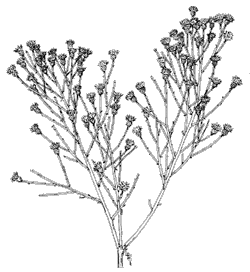 |
Range
Desert broom grows in desert, desert grassland, and chaparral from 1000 to 5000 feet (300-7500 m) elevation in Arizona, California, Sonora, and Baja California.
Notes
Desert broom is a pioneer plant that is efficient at colonizing newly-disturbed soil. Therefore it is often abundant in washes, roadsides, and abandoned plowed fields. Like many pioneer plants, it is rather short-lived, lasting only perhaps a couple of decades. Desert gardeners may dislike desert broom for its aggressively invasive nature, but it can be useful. As the vernacular names suggest, the thin terminal twigs can be bundled together at the end of a pole to make a broom. The flowers attract hordes of butterflies and other insects. Because it flowers in autumn, it’s a good plant for extending the season of a butterfly garden. Grow male plants (offered by some nurseries), if you wish to prevent unwanted volunteers. Unwanted plants have another horticultural use: desert broom branches create ideal shade to protect newly planted cacti and other plants from sunburn. Several layers of tip branches provide 50-75% shade; the twigs slowly disintegrate over several months and the sheltered plant gradually becomes acclimated to full desert sun. Such redeeming value can be found in some of the worst weeds.
The resinous leaves and stems are rarely eaten, except by jackrabbits during droughts when little else is available.
There are several other species of Baccharis. Waterweed (B. sergiloides, escoba amarga) grows in permanently wet soils. Seep-willow (B. salicifolia, formerly B. glutinosa) commonly forms dense thickets along waterways. Other plants called “broom” are in the legume family (Fabaceae or Leguminosae).
Baileya multiradiata
English name: desert marigold,
wild marigold, desert baileya
Spanish name: hierba amarilla
(yellow herb)
Description
Desert marigold is an annual or short-lived perennial with white-wooly leaves forming a dense mound about 6 to 8 inches (15-20 cm) in diameter. Flower heads perch well above the foliage on 1 foot long (30 cm) stems. The flat 1 inch (2.5 cm) daisies are bright yellow.
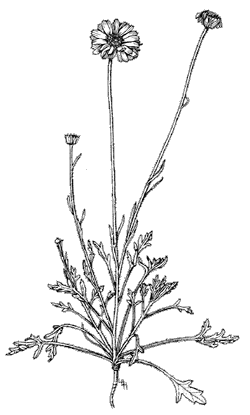 |
Range
Desert marigold grows mostly on bajadas and in valleys throughout the northern Sonoran, southern Mohave, and northern Chihuahuan deserts. It is one of the most common wildflowers, often abundant on disturbed soils such as road shoulders.
Notes
This is perhaps our most consistent showy roadside wildflower; it blooms in any season after a moderate rain. On hard soils such as caliche, desert marigold is replaced by the somewhat similar Bahia absinthifolia (which has no vernacular name except its genus name). The foliage of bahia is more sparsely distributed; its stems arise from perennial underground rhizomes that form colonies. Bahia leaves are less woolly and the flowers slightly smaller than are those of desert marigold. Bahia’s range extends into pine forests.
Bebbia juncea
English names: chuckwalla’s delight, sweetbush
Spanish names: chuparosa (sucked, e.g.,
by insects for nectar), junco (generic
name for rushes)
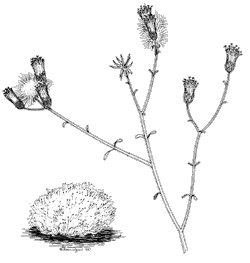 |
Description
Bebbia is an intricately-branched shrub to about 4 feet (1.2 m) tall and wide. The threadlike leaves are absent most of the year; the pencil-lead-thin stems are green and photosynthetic. The cylindrical, yellow flower heads are composed only of disk flowers. Flowering is almost year round, most heavily following rains.
Range
Bebbia is widespread in the arid and semiarid habitats of our region.
Notes
The vernacular name “chuckwalla’s delight” was invented by naturalist Edmund Jaeger, who observed that chuckwallas “feed greedily on the flowers.” Many desert plants have yellow flowers, and chuckwallas seek out and eat most of them.
Encelia farinosa
English name: brittlebush
Spanish names: rama blanca (white
branch), incienso (incense), hierba de
las animas (herb of the souls), hierba
del bazo (spleen-herb), palo blanco
(white stick), hierba ceniza (gray herb)
Description
Brittlebush is a somewhat woody shrub 3 to 5 feet (1-1.5 m) tall. The dense branching pattern tends to form a hemispherical mound, especially in very arid conditions. The leaves range from nearly hairless bright green through gray-green to white with a dense covering of soft matted hairs. Small yellow flowers are borne on multiply-branched stalks well above the leafy stems; they are usually produced in late winter to mid spring, with occasional bloom at other times.
Range
This distinctive plant is widespread and common in most of the Sonoran Desert and in warmer parts of the Mohave Desert.
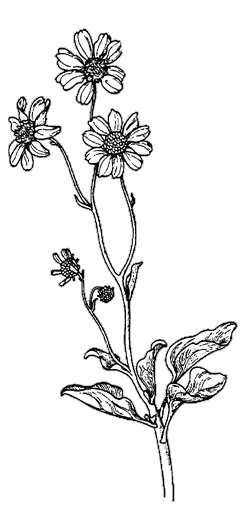 |
Notes
Brittlebush is very drought resistant and often forms nearly pure stands in extremely arid habitats. There is a widespread myth that creosote bush secretes toxins that kill all other plants growing nearby. In fact creosote bush doesn’t inhibit many annual plants, but brittlebush does. Rain water dripping off the foliage dissolves chemicals that inhibit the seed germination of many species. For this reason only a few species of annual wildflowers can grow under brittlebushes.
The more arid the conditions of the growing season, the smaller and whiter are the leaves produced. During prolonged drought the leaves are completely lost. It is fairly frost-tender; in Arizona Upland it tends to be restricted to slopes above the cold valley floors. The stems exude a gum that can be chewed or used for incense (hence the Spanish name incienso). The gum was once exported to Europe by the mission priests and is still used by the Tohono O’odham. The English name was given to it by members of the 1907 Sykes expedition to the Pinacate region; they dubbed it “white brittlebush.” (Read the fascinating tale of this pioneering adventure in Camp-Fires on Desert and Lava, by William Hornaday.)
Trixis californica
English name: trixis
Spanish names: plumilla (little feather),
arnica
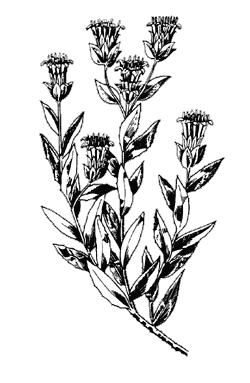 |
Description
Trixis is an evergreen shrub 1 to 3 feet (30-90 cm) tall that grows compact and upright in sun, but sparse and floppy when in the shade. The 1- to 2-inch (2.5-5 cm) long, dull green leaves emit a rank odor when bruised. The small yellow flower heads have a spicy fragrance. They appear at any time after a rain, with a peak bloom in spring. Range Trixis grows from southern California to west Texas, and south to central Mexico.
Notes
The Seri regard this plant as a panacea, claiming that there is nothing that this medicinal herb is not good for. Among its wide range of uses, trixis is smoked like tobacco and administered as an aid to childbirth. Trixis is successful in many habitats from low desert on the Colorado River to woodlands at 5500 feet (1700 m) elevation. If enough soil moisture is available, it grows anywhere temperatures remain above freezing. Moreover, it belongs to a subgroup of composites (tribe Mutiseae) that is mostly South American. There are many plant and animal groups with similar distribution patterns—a large number of species in their “home” areas, a few of which become very successful, extending their ranges far beyond their places of origin. There is something special about the biology of trixis, but we don’t know what it is.










